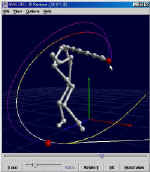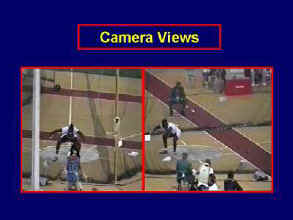1.1 Gait Analysis Basics
Introduction
Gait analysis is a sophisticated laboratory technique by
which modern electronics are used to incorporate information from a number of
inputs to illustrate and analyze the dynamics of gait. It describes for the
clinician (physician, surgeon, therapist) in quantitative and dynamic terms the
movement of the body and its limbs and the changing relationships of one
extremity to other extremities during motion (e.g.: walking, leg raising). It
helps the clinician judge what are the forces resulting in a dysfunction in
movement of a limb and what is the result of compensating for the dysfunction;
to put it another way, what is cause and what is effect.
Gait analysis has become particularly useful to the surgical
team when decisions need to be made about the applicability of a surgical
procedure for correction of a faulty gait. It is also valuable after surgery to
learn whether the dysfunction has been corrected and how motion of the treated
limb is now effecting the dynamics of walking.
Although the technology of gait analysis continues to be
studied, it has moved from an "experimental" methodology to the realm
of a tool in clinical practice. We can anticipate future improvements in the
technology of gait analysis and in the interpretation of its results; however,
gait analysis has reached the status of a clinical laboratory test used by
clinicians when specific information is necessary as a guide to therapy.
Gait analysis relies upon the use of sophisticated equipment
by a team of experts from several disciplines. Because of this, gait analysis is
a relatively expensive laboratory examination. However, when used judiciously it
has become a useful instrument in appraisal of gait dysfunction and in the
evaluation of the results of clinical therapy
Gait analysis is the quantitative measurement of locomotion.
It provides objective analysis of pathological locomotion and understanding of
the mechanisms which lead to optimum walking ability.
Using advanced three-dimensional gait analysis systems it is possible to:
 |
Measure accurately deviations from normal in the gait
pattern. |
 |
Determine the cause of gait abnormalities. |
 |
Provide information to assist clinical decision making in
the areas of surgery, therapy and orthotics. |
 |
Evaluate the outcome of intervention to maximize the
result. |
Why Use Gait Analysis?
Gait is complex and difficult to assess visually. Gait analysis provides a
repeatable and reliable method of measuring walking. Surgical, orthopedic and
therapeutic recommendations are commonly based on clinical examination alone.
Since visually similar gait patterns can be generated from a variety of
underlying pathologies, the outcome of intervention can be disappointing and
subject to error. A more scientific evaluation can be provided by the use of
clinical gait analysis. Interpretation of kinetic and kinematic data using
advanced computer technology can, for example, distinguish between primary gait
abnormalities and compensatory mechanisms. This allows a more certain outcome
from selective surgical intervention, more precise prescription of orthopedic
provision and therapeutic recommendations, leading to improved walking ability.
The Foundation of APAS/Gait - Equipment and Methodology

Human gait analysis with motion capture video systems and interactive
3d modeling systems help doctors analyze, diagnose, and document aberrant gaits with
tools that compare the gaits of patients before and after treatment to historical case
studies of normal and abnormal gaits.
The primary mission of the gait laboratory is to provide
objective quantitative information on normal and pathological function which can be
ultimately applied to the improved evaluation and treatment of musculoskeletal disease and
injury.
Gait analysis combines expertise from orthopaedics, physical
therapy, and biomechanics to objectively evaluate the walking patterns of children with
gait disturbances. These walking problems may be caused by cerebral palsy, amputation,
myelodysplasia, clubfoot or other neuromuscular problems, or traumatic injury.
A gait evaluation consists of a number of tests performed during
a single outpatient visit. A typical analysis will consist of a clinical evaluation,
visual documentation of your child's current gait status, and measurement of gait
performance using highly advanced technology. Each of these tests can help to identify the
possible causes of gait-related problems. This data is reviewed by an orthopaedic
physician to help determine treatment options for your child, and later to help evaluate
your child's response to the treatment.
Every Gait System includes 3 primary components
-
Kinematics: Analysis of movement of the body and its segments, without calculation of
forces
-
Kinetics: Analysis of Forces and Moments acting on the body segments.
-
Neuromuscular Activation measured by Electromyography.
Kinematics:

The Kinematics process involve capturing of video or markers location in order
to determine the coordinate of calculated joint center. These coordinates allow the
calculation of body’s joint positions relative to Global and Local Coordinate system.
Further derivatives allow calculation of velocities and accelerations in 3D space.
Kinematics Basics
Kinetics Basics
Basic Technology Required for Gait Analysis
Available equipment:
Goniometry:
These equipment consist of potentiometer placed between two bars. One bar is strapped
to the proximal segment and the second to the distal segment. The potentiometer gives a
varying voltage output correlate with the angle between the two bars. Any combination of 3
potentiometers can give three angles of rotation. This method of analysis require long
preparation time, repeatability problem in placement, cross talk and reliability problems.
Imaging Systems:
Cinematography:

In the old time, only 15 years ago, film was the most versatile means of
recording Human Movement. However, today, almost exclusively, video is used to capture
Human movement. For 2D analysis, only one camera is required. For 3D, the
requirement is at least 2 cameras. However, any number of cameras can be used.
Videography:
The most frequently employed approach to
automated motion analysis is the use of video technology. Typically these systems
automatically track reflective markers covered with a highly reflective material. Each
camera has a source of light, normally infrared LED's, surrounding the lens. The markers
reflect the light back to the cameras. The video signal is either fed into a computer via
a "frame grabber" or is analyzed by a hardware video processor. The computer or the video
processors examine the video data looking for objects above a threshold of light. In these
systems the reflective markers are the brightest objects and the thresholding can be set
to automatically discriminate the markers. The cluster of 'pixels' seen above the
threshold are then examined to form markers and the centroids of the markers are
automatically computed in the two dimensional image plane of the cameras. The difficulty
with these system is that any marker can be visible at any time therefore the objects have
to be sorted. This is normally done in the 3D reconstruction of the object space. In this
process the 3D coordinates of markers seen in at least 2 camera are generated. In human
motion such markers generally form 3D trajectories that are easily distinguished and link
together. The process of forming 3D trajectories after data collection, in post
processing, in known as tracking. Modern algorithms for tracking have drastically reduced
the data turn around time.
The use of markers to track body kinematics is not without problems:
Identification of standard bony landmarks can be unreliable. The soft tissue
overlying the bony landmarks can move, giving rise to noisy data. The marker
itself can wobble due to its own inertia Markers can even come adrift completely.
Children are often irritated by the markers and pull them off.
marker sets Discussion
by the Experts
The commonly heard names in this area
are "flock of birds" and Polhemus. Electromagnetic devices have emerged from the growth of
virtual reality in the computer industry. These system detect the motion of sensors placed
on each segment in an electromagnetic field. They provide real time six degree of freedom
data. The limitations appear to be the cabling necessary to connect the sensors, sampling
frequency, the number of sensors that can be followed at one time and the cost. The use of
this equipment is growing in areas of human motion analysis, other than gait.
The underlying
fundamentals that are central to successful determination
of kinematics in gait analysis
-
Marker sets must have defined relationship to the underlying anatomy.
-
Three dimensional techniques must be employed.
-
Quality of the results of gait analysis depends upon the care with which the marker
set is applied and necessary measurement are made.
-
Joint centers and segmental coordinate systems must be accurately determined
Sources of Error in Gait
Analysis:
Primary sources of error:
 |
Limitations of measuring equipment |
 |
Resolution (number of pixels broken into) |
 |
Field size (change for differing needs) |
 |
Calibration |
 |
Recognizing markers size (merging or obstructed markers) |
 |
Centroid calculations |
 |
Resolution and accuracy (bottom line 1-3mm, 2-4 mm more typical) |
 |
Skin motion (skin marker movement 2-4mm) |
 |
Distance between markers |
 |
Anthropometric measurements |
 |
Joint center and axes of rotation calculations |
 |
Repeatability of identifying axes |
 |
Movement of axis |
 |
Errors in locating can greatly affect kinetics |
 |
Sample hip center determination (not the best for inferior/superior and a/p
determination) |
APAS/Gait was
designed to maximize analysis efficiency and minimize any errors. APAS/Gait integrates
video with markers sets. It allows the investigator to select any of the markers sets
available.
In addition, where the
average cost of any gait system is around $200,000, APAS/Gait is priced only $5000.
You can download the system for free and try it for
yourself. Try it, use it, and then let us know. We are sure you will love it.
|